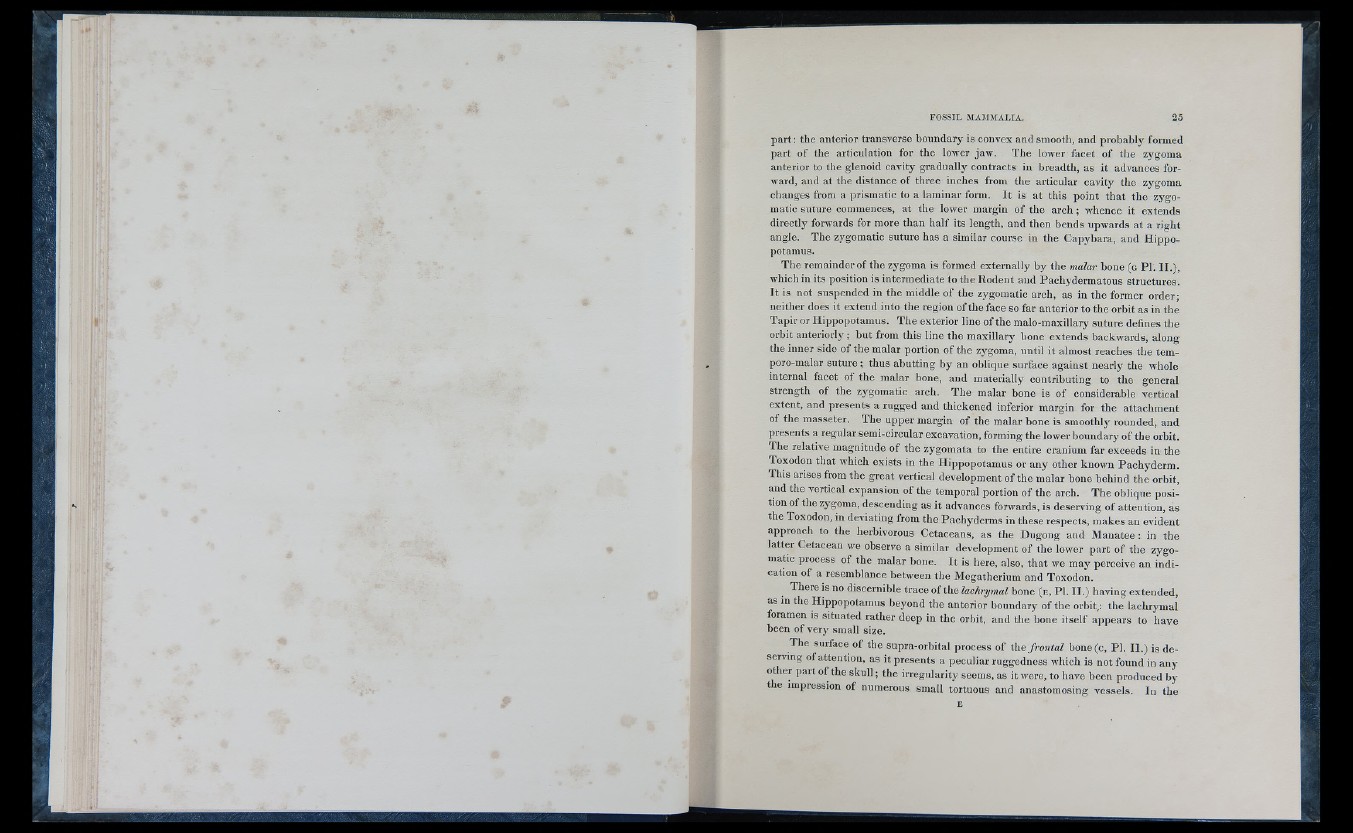
part; the anterior transverse boundary is convex and smooth, and probably formed
part o f the articulation for the lower jaw. The lower facet o f the zygoma
anterior to the glenoid cavity gradually contracts in breadth, as it advances forward,
and at the distance o f three inches from the articular cavity the zygoma
changes from a prismatic to a laminar form. It is at this point that the zy g o matic
suture commences, at the lower margin o f the arch ; whence it extends
directly forwards for more than h a lf its length, and then bends upwards at a right
angle. The zygomatic suture has a similar course in the Capybara, and Hippo potamus.
The remainder o f the zygoma is formed externally b y the malar bone ( g PI. II.),
which in its position is intermediate to the Rodent and Pachydermatous structures.
It is not suspended in the middle o f the zygomatic arch, as in the former order;
neither does it extend into the region o f the face so far anterior to the orbit as in the
Tapir or Hippopotamus. T he exterior line o f the malo-maxillary suture defines the
orbit anteriorly ; but from this line the maxillary bone extends backwards, along
the inner side o f the malar portion o f the zygoma, until it almost reaches the tem-
poro-malar su tu r e ; thus abutting b y an oblique surface against nearly the whole
internal facet of the malar bone, and materially contributing to the general
strength o f the zygomatic arch. The malar bone is o f considerable vertical
extent, and presents a rugged and thickened inferior margin for the attachment
o f the masseter. Th e upper margin o f the malar bone is smoothly rounded, and
presents a regular semi-circular excavation, forming the lower boundary o f the orbit.
The relative magnitude o f the zygomata to the entire cranium far exceeds in the
Toxodon that which ex ists in the Hippopotamus or any other known Pachyderm.
This arises from the great vertical development o f the malar bone behind the orbit,
and the vertical expansion o f the temporal portion o f the arch. The oblique p o sition
of the zygoma, descending as it advances forwards, is deserving o f attention, as
the Toxodon, in deviating from the Pachyderms in these respects, makes an evident
approach to the herbivorous Cetaceans, as the Dugong and Manatee : in the
latter Cetacean we observe a similar development o f the lower part o f the zygomatic
process o f the malar bone. I t is here, also, that we may perceive an in d ication
o f a resemblance between the Megatherium and Toxodon.
There is no discernible trace o f the lachrymal bone ( e , PL II.) having extended,
as in the Hippopotamus beyond the anterior boundary o f the orbit,; the lachrymal
oramen is situated rather deep in the orbit, and the bone its e lf appears to have
been o f very small size.
The surface of the supra-orbital process o f the f rontal bone (c, PL II.) is deserving
of attention, as it presents a peculiar ruggedness which is not found in any
other part o f the sk u ll; the irregularity seems, as it were, to have been produced by
t e impression o f numerous small tortuous and anastomosing v e s s e ls . In the